| Skip Navigation Links | |
| Exit Print View | |

|
Sun Server X4-2L HTML Documentation Collection |
Getting the Latest Software and Firmware
About the Installation Procedure
Installation Procedure Overview
Preparing for Server Installation
Server Physical Specifications
Tools and Equipment Needed for Installation
Optional Component Installation
About Server Features and Components
Front Panel Status Indicators, Connectors, and Drives
Back Panel Status Indicators, Connectors, Drives, and PCIe Slots
Server Management Software Overview
Getting Server Firmware and Software Updates
Firmware and Software Access Options
Getting Firmware and Software From MOS or PMR
Installing Updates Using Other Methods
Installing the Server Into a Rack
Safety Precautions When Rackmounting the Server
Stabilize the Rack for Installation
Attach Tool-less Slide-Rail Assemblies
Install the Server Into the Slide-Rail Assemblies
Install the Second-Generation Cable Management Arm
Remove the Second-Generation Cable Management Arm
Install the First-Generation Cable Management Arm
Verify Operation of Slide-Rails and CMA
Rear Cable Connections and Ports
Attaching Data Cables to the Server
Connecting Power Cords to the Server
Oracle ILOM Hardware and Interfaces
Logging In to Oracle ILOM Using a Local Serial Connection
Logging In to Oracle ILOM Using a Remote Ethernet Connection
Accessing the Host Console Through Oracle ILOM
Troubleshooting the Service Processor Connection
Setting Up Software and Firmware Using Oracle System Assistant
Accessing Oracle System Assistant
Setting Up Software and Firmware Using Oracle System Assistant
Set Up Software and Firmware Using Oracle System Assistant
Setting Up an Operating System and Drivers
Configuring Server Drives for OS Installation
RAID Configuration Requirements
Configuring Storage Drives Into RAID Volumes Using Oracle System Assistant
Configuring RAID Using the BIOS RAID Configuration Utilities
Configuring the Preinstalled Oracle Solaris 11.1 Operating System
Preinstalled Oracle Solaris 11.1 Image BIOS Boot Mode Restriction
Preinstalled Operating System RAID Limitations
Oracle Solaris 11.1 Configuration Worksheet
Configure the Preinstalled Oracle Solaris 11.1 Operating System
Oracle Solaris 11.1 Operating System Documentation
Configuring the Preinstalled Oracle Linux 6. x Operating System
Preinstalled Oracle Linux Image BIOS Boot Mode Restriction
Oracle Linux 6.x Configuration Worksheet
Configure the Preinstalled Oracle Linux 6.x Operating System
Registering Oracle Linux and Activating Automatic Update
Oracle Linux 6.x Operating System Documentation
Configuring the Preinstalled Oracle VM 3.2 Software
Preinstalled Oracle VM Image BIOS Boot Mode Restriction
Preinstalled Oracle VM Server and Oracle VM Manager Compatibility Requirements
Oracle VM Server Configuration Worksheet
Configure the Preinstalled Oracle VM Server
Powering Off the Server for Orderly Shutdown
Powering Off the Server for Immediate Shutdown
Troubleshooting Installation Issues
Technical Support Information Worksheet
Locating the System Serial Number
About Oracle Solaris Operating System Installs
Oracle Solaris OS Installation Task Map
Selecting the Console Display Option
Selecting the Boot Media Option
Selecting the Installation Target Option
Oracle Solaris OS Installation Options
Oracle System Assistant Overview
Preparing to Install the Operating System
Installing the Oracle Solaris Operating System
Installing Oracle Solaris on a Single System Using Oracle System Assistant
Installing the Oracle Solaris 10 or 11 Operating System on a Single System Using Media
Oracle VM Installation Task Map
Selecting the Console Display Option
Selecting the Boot Media Option
Selecting the Installation Target Option
Oracle VM Installation Options
Oracle System Assistant Overview
Preparing to Install Oracle VM
Verify the BIOS Factory Defaults
Disable VT-d and SR-IOV in BIOS
Installing Oracle VM on a Single System Using Oracle System Assistant
Installing Oracle VM on a Single System Using Media
Post Installation Tasks for Oracle VM
Configuring Network Interfaces
About Linux Operating System Installs
Supported Linux Operating Systems
Oracle Unbreakable Enterprise Kernel for Linux
Selecting the Console Display Option
Selecting the Boot Media Option
Selecting the Installation Target Option
Oracle System Assistant Overview
Preparing to Install the Operating System
Installing a Linux Operating System
Installing a Linux OS on a Single System Using Oracle System Assistant
Install a Linux OS Using Oracle System Assistant
Installing Oracle Linux on a Single System Using Media
Oracle Linux OS Installation Task Map
Install Oracle Linux 5 Using Local or Remote Media
Install Oracle Linux 5.x or 6.x Using PXE Network Boot
Post Installation Task for Oracle Linux
Installing Red Hat Enterprise Linux on a Single System Using Media
Install RHEL 5.x Using Local or Remote Media
Install RHEL 6.x Using Local or Remote Media
Install RHEL 5.x or 6.x Using PXE Network Boot
Post Installation Tasks for RHEL
Register RHEL and Activate Automatic Updates
Installing SUSE Linux Enterprise Server on a Single System Using Media
Install SLES 11 Using Local or Remote Media
Install SLES 11 Using PXE Network Boot
Post Installation Tasks for SLES 11
Update the SLES Operating System
Configuring Network Interfaces
About Microsoft Windows Server Operating System Installs
Windows OS Installation Task Map
Supported Windows Operating Systems
SAS PCIe HBAs Requiring LSI Mass Storage Driver for Windows Server 2008 SP2
Selecting the Console Display Option
Selecting the Boot Media Option
Selecting the Installation Target Option
Windows OS Installation Options
Oracle System Assistant Overview
Preparing to Install the Operating System
Installing a Windows Server Operating System
Installing Windows Server on a Single System Using Oracle System Assistant
Installing Windows Server on a Single System Using Media
Post Installation Tasks for Windows Server
Supplemental Software Component Options
Installing Device Drivers and Supplemental Software
VMware ESXi Installation Task Map
Supported VMware ESXi Software
Selecting the Console Display Option
Selecting the Boot Media Option
Selecting the Installation Target Option
VMware ESXi Installation Options
Preparing to Install VMware ESXi
Configuring the VMware ESXi 5.0 Software or the Server Hardware to Support Network Connections
Installing VMware ESXi on a Single System Using Media
Post Installation Tasks for VMware ESXi
Configure Network Adapter Settings
Determine the MAC Address of a Connected Server Network Port
Update the VMware ESXi Software
Configuring Network Interfaces
About Server and Component Status Indicators
Service Troubleshooting Task List
Locate the Server Serial Number
Electrostatic Discharge Safety
Preparing the Server for Component Replacement
Servicing CRUs That Do Not Require Server Power-Off
Servicing Storage Drives and Rear Drives (CRU)
Servicing Power Supplies (CRU)
Servicing CRUs That Require Server Power-Off
Servicing the SAS Expander Module (CRU)
Servicing the Air Baffle (CRU)
Servicing the Internal USB Flash Drives (CRU)
Servicing the Front and Rear Storage Drive Backplanes (FRU)
Servicing the Front LED/USB Indicator Modules (FRU)
Servicing the Motherboard Assembly (FRU)
Returning the Server to Operation
Server Filler Panel Requirements
Remove and Install Filler Panels
Reinstall the Server Chassis in the Rack
Return the Server to the Normal Rack Position
Reconnect Power and Data Cables
Setting Up BIOS Configuration Parameters
Managing the BIOS Configuration
Accessing the BIOS Setup Utility
Using BIOS for Resource Allocation
Common BIOS Setup Utility Tasks
BIOS Setup Utility Menu Options
UEFI Driver Control Menu Selections
BIOS Save & Exit Menu Selections
Monitoring Components and Identifying SNMP Messages
Monitoring Component Health and Faults Using Oracle ILOM
This procedure describes how to install the Oracle Linux operating system from local or remote media. The procedure assumes that you are booting the Oracle Linux installation media from one of the following sources:
Oracle Linux 6.3, 6.4, or 6.5 CD or DVD set (internal or external CD/DVD)
Oracle Linux 6.3, 6.4, or 6.5 ISO DVD image (network repository)
Note - If you are booting the installation media from a PXE environment, refer to Install Oracle Linux 5.x or 6.x Using PXE Network Boot for instructions.
For additional information about how to set up the installation media, see Selecting the Boot Media Option.
For example, to reset the server:
The BIOS screen appears.

Note - The next events occur very quickly; therefore, focused attention is needed for the following steps. Watch carefully for these messages as they appear on the screen for a brief time. You might want to enlarge the size of your screen to eliminate scroll bars.
The Please Select Boot Device menu appears. The screen that appears will be different depending on whether you have BIOS configured for Legacy BIOS or UEFI BIOS.
For Legacy BIOS, the following screen appears:
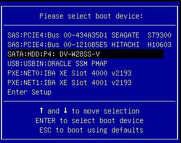
For UEFI BIOS, the following screen appears:

Note - The boot device menu that appears in your installation might differ depending on the type of disk controller installed in your server.
For example:
For Legacy BIOS, the Oracle Linux 6.x Welcome screen appears.
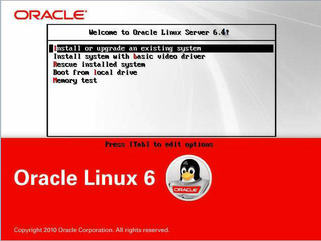
For UEFI BIOS, the Oracle Linux 6.x GNU GRUB screen appears.
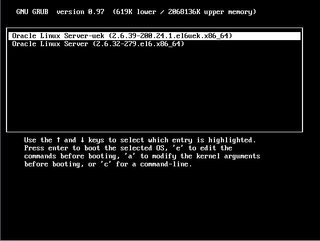
To install from Legacy BIOS Boot Mode, select Install or Upgrade an Existing System from the Oracle Linux 6.x Welcome screen, click Next at the bottom of the screen, and follow the on-screen prompts to complete the interactive installation. When the installation is complete, proceed to Step 17.
To install from UEFI BIOS Boot Mode, select Oracle Linux Server 6.x from the GNU GRUB screen and press Enter.
The Choose a Language screen appears.
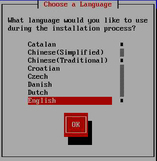
The Keyboard Type screen appears.
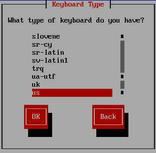
The Installation Method screen appears.

The Disc Found screen appears.
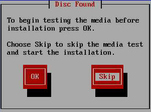
The Oracle Linux 6 splash screen appears.
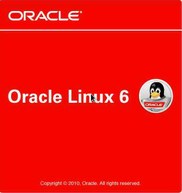
If there is a problem with the data format on any target disk, the Partitioning Error warning appears.

If this is the storage drive that you want to use for the installation, you need to reformat the drive; otherwise, you can ignore this warning.
To reformat the disk, click Yes.
Otherwise, the Installation Devices screen appears.
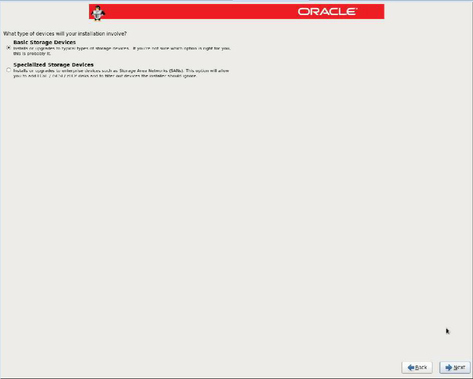
The Examining Devices screen appears.

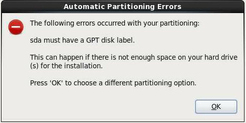
If the above screens appears, the disk to which you are attempting to install the Linux OS is formatted incorrectly and it needs to be reformatted.
Note - This error occurs if you attempt to do a UEFI BIOS OS install to a storage drive that was previously used to store data in Legacy BIOS format or vice versa. UEFI uses the GUID Partition Table (GPT) format, while Legacy BIOS formats storage drives in the Master Boot Record (MBR) format. The storage drives that ship with the server are new, so they are unformatted. You will not encounter this error when installing to an unformatted disk.
To recover and reformat the disk without aborting the install, click the keyboard Back button on the install screen several times to return to the initial splash screen shown in Step 9 and perform these steps:
The shell appears.
anaconda root@localhost /]# parted /dev/sdc GNU Parted 2.1 Using /dev/sdc Welcome to GNU Parted! Type ‘help' to view a list of commands. (parted) p Model: HITACHI H106030SDSUN300G (scsi) Disk /dev/sdc: 300GB Sector size (logical/physical): 512B/512B Partition Table: msdos Number Start End Size Type File system Flags 1 1049kB 21.5GB 21.5GB primary ext2 (parted) mklabel New disk label type? gpt Warning: The existing disk label on /dev/sdc will be destroyed and all data will be lost. Do you want to continue? Yes/No? yes (parted) p Model: HITACHI H106030SDSUN300G (scsi) Disk /dev/sdc: 300GB Sector size (logical/physical): 512B/512B Partition Table: gpt Number Start End Size File system Name Flags (parted) g Information: You may need to update /etc/fstab. anaconda root@localhost /]#
Otherwise, the Bootloader screen appears.

The Select Software screen appears.
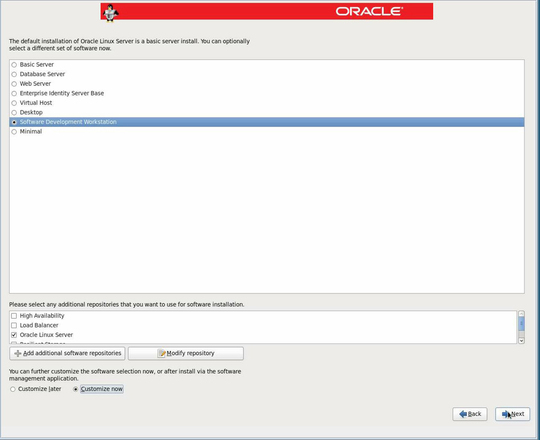
The Starting the Installation Process screen appears.
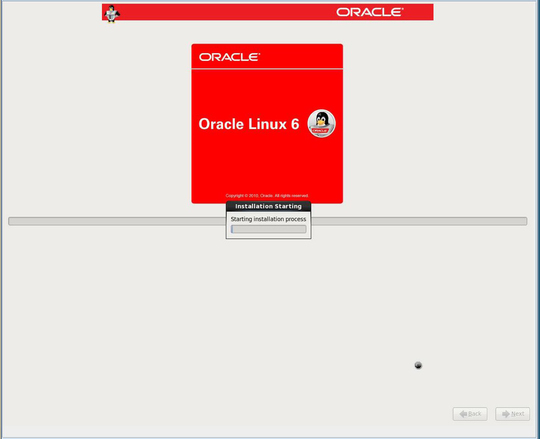
You have completed the installation user interactions.
The BIOS screen appears.

For Legacy BIOS, the following BIOS Setup Utility appears.
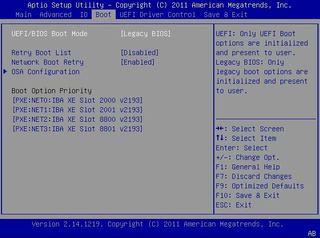
For UEFI BIOS, the following BIOS Setup Utility appears.
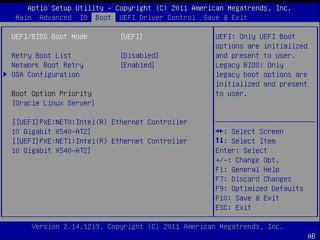
For Legacy BIOS:
Select Boot in the top menu bar and verify the target installation storage drive is at the top of the list under the Boot Option Priority field.
If the target installation storage drive is not at the top of the list, move it to the top and press F10 to save the change and exit the BIOS Setup Utility.
For UEFI BIOS:
Select Boot in the top menu bar and verify the Oracle Linux Server is at the top of the list under the Boot Option Priority field.
If Oracle Linux Server is not at the top of the list, move it to the top and press F10 to save the change and exit the BIOS Setup Utility.
As the reboot continues, a kernel screen appears.
For Oracle Linux 6.3, the following screen appears.
Press any key to enter the menu Booting Oracle Linux Server-uek (2.6.39-200.24.1.el6uek.x86_64) in 2 seconds...
For Oracle Linux 6.4, the following screen appears.
Press any key to enter the menu Booting Oracle Linux Server Unbreakable Enterprise Kernel (2.6.39-400.17.1.el6uek.x86_64) in 2 seconds...
For Oracle Linux 6.5, the following screen appears.
Press any key to enter the menu Booting Oracle Linux Server Unbreakable Enterprise Kernel (3.8.13-16.2.1.el6uek.x86_64) in 2 seconds...
Note - The Red Hat compatible kernel is not supported on Oracle Linux 6.3.